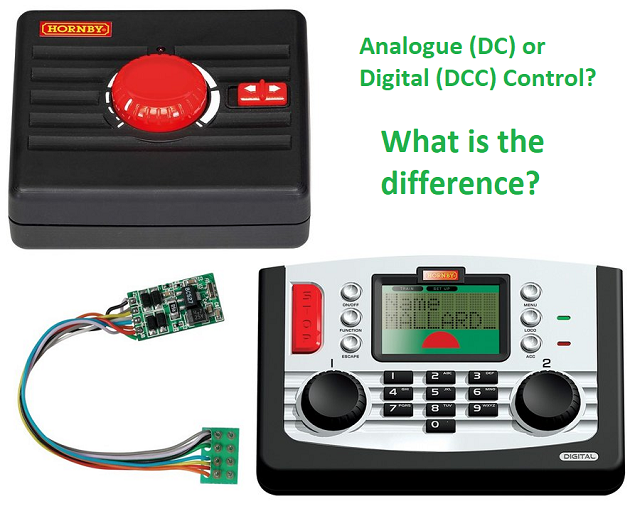In the world of model trains, the choice between DC and DCC control systems can make a significant difference in the functionality and enjoyment of your miniature railway empire. While both options have their merits, understanding the distinctions between them is crucial for any avid hobbyist. DC control systems operate on a direct current, allowing for independent control of multiple locomotives on the same track. On the other hand, DCC control systems utilize digital command signals to control various aspects of the model train, including speed, direction, and lighting, all while enabling individual control of each locomotive. So, whether you prefer simplicity or versatility, it’s time to dive into the fascinating world of DC versus DCC for your model train collection.

DC Control Systems
Introduction to DC Control Systems
DC control systems, also known as Direct Current control systems, are a popular choice for model train enthusiasts. These systems use a continuous current to power the locomotives and control their speed and direction. DC control systems have a long history and have been widely used in the model train industry for many years.
Basic Functionality of DC Control Systems
DC control systems rely on the principle of controlling the voltage supplied to the track to control the speed and direction of the trains. In a basic DC control system, the voltage is supplied through the tracks to the locomotive. By adjusting the voltage, you can increase or decrease the speed of the train. Changing the polarity of the voltage reverses the direction of the train.
Power Supply for DC Control Systems
To operate a DC control system, you will typically need a power supply that can convert the AC power from your wall outlet into the DC power required for your trains. The power supply provides the necessary voltage and current to operate your trains.
Wiring Requirements for DC Control Systems
When it comes to wiring a DC control system, simplicity is key. You will need to connect the power supply to the tracks using the appropriate wiring. It is important to ensure that the wiring is secure and properly insulated to avoid any short circuits or electrical hazards.
Advantages of DC Control Systems
DC control systems offer several advantages for model train enthusiasts. One of the main advantages is the affordability. DC control systems are generally more affordable compared to other types of control systems, making them a popular choice for beginners. Additionally, DC control systems are relatively easy to understand and operate, making them a great option for hobbyists of all skill levels.
Disadvantages of DC Control Systems
While DC control systems have their advantages, they also come with a few limitations. One of the main disadvantages is the inability to operate multiple trains independently on the same track. With a DC control system, you can only control one train at a time, which may limit the flexibility and realism of your model train layout. Additionally, DC control systems do not offer some of the advanced features and functions found in other control systems, such as sound effects or digital command control.
Compatibility with Model Train Types
DC control systems are compatible with a wide range of model train types, including locomotives that are specifically designed for DC operation. However, it is important to ensure that the locomotives and accessories you choose to use with your DC control system are compatible with the system’s voltage and wiring requirements.
Recommended Brands for DC Control Systems
There are several reputable brands that offer DC control systems for model trains. Some of the recommended brands include Bachmann, Digitrax, and NCE. These brands have a proven track record and offer reliable and user-friendly DC control systems.
Cost of DC Control Systems
The cost of DC control systems can vary depending on the brand, features, and functionality. However, compared to other control systems, DC control systems tend to be more affordable. Basic DC control systems can range from around $50 to $200, while more advanced systems with additional features can cost upwards of $500 or more.
Popular Features of DC Control Systems
While DC control systems may not offer the extensive features of other control systems, they still have some popular features that enhance the model train experience. These features may include variable speed control, momentum control, and the ability to control accessories such as lights and sounds. Some DC control systems also have built-in circuit protection to prevent damage to the locomotives and the system itself.
DCC Control Systems
Introduction to DCC Control Systems
DCC control systems, also known as Digital Command Control systems, have revolutionized the model train industry. Unlike DC control systems, which rely on voltage variations to control the trains, DCC control systems use digital signals to send commands to the locomotives.
Basic Functionality of DCC Control Systems
In a DCC control system, each locomotive is equipped with a decoder that receives digital commands from the control system. These commands contain information about the desired speed, direction, and other functions of the train. The decoder then translates these commands into electrical signals, which control the locomotive’s motor and other features.
Power Supply for DCC Control Systems
To power a DCC control system, you will need a dedicated power supply that can provide the required voltage and current for your trains. This power supply is generally connected to the control system through a bus or wiring network.
Wiring Requirements for DCC Control Systems
Unlike DC control systems, DCC control systems require more complex wiring. In addition to connecting the power supply, you will need to install decoders in each locomotive and run wiring to connect all the decoders to the control system. It is essential to follow the manufacturer’s instructions and guidelines when wiring a DCC control system to ensure proper operation.
Advantages of DCC Control Systems
DCC control systems offer several advantages over traditional DC control systems. One of the main advantages is the ability to operate multiple trains independently on the same track. Each train equipped with a decoder can receive individual commands, allowing for realistic and dynamic operations. DCC control systems also offer advanced functions, such as sound effects, lighting control, and programmability, which enhance the overall model train experience.
Disadvantages of DCC Control Systems
While DCC control systems have many advantages, they also come with a few disadvantages. One of the main disadvantages is the cost. DCC control systems tend to be more expensive compared to DC control systems, especially when factoring in the cost of decoders for multiple locomotives. Additionally, setting up and wiring a DCC control system can be more challenging, especially for beginners.
Compatibility with Model Train Types
DCC control systems are compatible with a wide range of model train types, including locomotives designed for both DC and DCC operation. However, it is important to ensure that your locomotives and accessories are compatible with DCC decoders and wiring requirements before incorporating them into your layout.
Recommended Brands for DCC Control Systems
There are several reputable brands that offer DCC control systems for model trains. Some of the recommended brands include Digitrax, NCE, and Lenz. These brands are known for their reliability, advanced features, and compatibility with various locomotives and accessories.
Cost of DCC Control Systems
The cost of DCC control systems can vary significantly depending on the brand, features, and complexity. Basic DCC starter sets typically range from $100 to $300, while more advanced systems with additional features can cost upwards of $500 or more. It is important to consider your budget and specific needs when choosing a DCC control system.
Popular Features of DCC Control Systems
DCC control systems offer a wide range of popular features that enhance the realism and functionality of model trains. Some of these features include multi-train operation, sound effects, lighting control, programmability, and the ability to control accessories such as turnouts and signals. DCC control systems also allow for more precise speed control and smooth acceleration and deceleration, creating a more realistic train operation.


